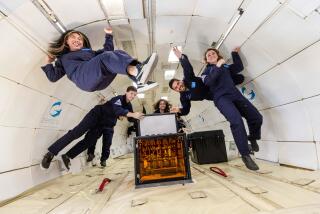MIT Launches International Space University
- Share via
CAMBRIDGE, Mass. — Hunched over architectural drawings of a lunar base module, 22-year-old Richard Fournier sketched a future he would like to experience.
The aerospace engineering student from Toulouse, France, is one of 104 students from 21 countries gathered on the campus of the Massachusetts Institute of Technology last summer in the first session of the International Space University.
They are scientists, engineers, policy makers and future astronauts with one thing in common: the dream of a global effort to explore and colonize space.
The space university has given students a comprehensive look at space, Fournier said.
Each student was deluged with material during 240 hours of lectures on subjects from orbital debris to international space law and problems of bone decalcification in space.
The first effort of its kind, the space university is intended to “set forth an agenda for space exploration” and create a “coherent space culture,” said Todd B. Hawley, ISU’s administrator and co-founder and a space policy expert.
His co-founder is ISU director Peter H. Diamandis, who is simultaneously pursuing a Harvard Medical School degree and a doctorate in aerospace engineering at MIT. He has patented a device that would allow astronauts to sleep better in space.
Both are committed to the notion of space as a laboratory for international cooperation.
Global Undertaking
“Over time there will be a global space culture and there has to be an understanding of what is possible on an international basis,” Hawley said. “The thing that has been missing until now has been a forum in which people can meet and see in a flashbulb sense the entire space field.”
In 1985, Hawley and Diamandis formed the Space Generation Foundation to develop ideas for international space exploration. They raised $100,000 and came up with nine schemes--including a university where people from around the world could gather to learn from experts in all space-related fields.
Since a founding conference at MIT in April, 1987, they have raised more than $1 million from government, private and corporate sources--including $100,000 from the Soviet Union to enroll 12 students. About a third of the 350 students and professionals from around the world who applied for this year’s course were accepted and their home countries paid the $10,000 fee.
“We are the countries with the highest technology and we must cooperate,” said Alexander Prokhorov, 24, a graduate student at the Institute of Aircraft Technologies in Moscow. “All peaceful coexistence in space is a better alternative than (the Strategic Defense Initiative). It’s better to go to Mars or Venus together.”
During the nine-week session, ISU students also tested space shuttle suits, operated a robot through a simulated scavenging of the lunar surface, and built model lunar mining vehicles and tested them in sandboxes.
The 84 lecturers from 14 countries were drawn from the world’s top space organizations, including the Jet Propulsion Laboratory at Caltech, the European Space Agency, the Soviet Cardiology Research Center and the International Telecommunications Satellite Organization.
ISU will remain a summer school until 1992, when the founders hope to begin a five-year degree program with a permanent faculty, a central campus and satellite campuses at the world’s top space facilities.
More to Read
Sign up for Essential California
The most important California stories and recommendations in your inbox every morning.
You may occasionally receive promotional content from the Los Angeles Times.









